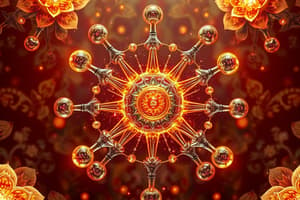Podcast
Questions and Answers
What is the role of valence electrons in chemical bonding?
What is the role of valence electrons in chemical bonding?
- Balancing the charge of an atom
- Determining the atomic number of an element
- Predicting the properties and reactions of elements (correct)
- Defining the isotope composition of an element
How many valence electrons do alkali metals (Group 1 elements) typically have?
How many valence electrons do alkali metals (Group 1 elements) typically have?
- One (correct)
- Eight
- Two
- Seven
What type of bond forms between a metal and a non-metal with electron transfer?
What type of bond forms between a metal and a non-metal with electron transfer?
- Ionic bond (correct)
- Hydrogen bond
- Polar covalent bond
- Covalent bond
According to the octet rule, atoms strive to achieve a stable electron configuration by having how many valence electrons?
According to the octet rule, atoms strive to achieve a stable electron configuration by having how many valence electrons?
What is the purpose of atomic orbitals in forming molecular orbitals?
What is the purpose of atomic orbitals in forming molecular orbitals?
What are valence electrons?
What are valence electrons?
How many electrons can the second shell of an atom hold?
How many electrons can the second shell of an atom hold?
What is the relationship between an atom's valence electrons and its chemical behavior?
What is the relationship between an atom's valence electrons and its chemical behavior?
Which element is likely to form more bonds: an element with 1 valence electron or an element with 6 valence electrons?
Which element is likely to form more bonds: an element with 1 valence electron or an element with 6 valence electrons?
What does the term 'valency' refer to in relation to elements?
What does the term 'valency' refer to in relation to elements?
Flashcards are hidden until you start studying
Study Notes
Understanding Atomic Structure: Valence Electrons and Their Role
Atoms, the building blocks of all matter, are composed of three main components: protons, neutrons, and electrons. To grasp the intricate dance of valence electrons — the focus of our exploration — let's briefly review the basic structure of an atom and its fundamental properties.
Atomic Structure
An atom's nucleus contains positively charged protons and (usually) a number of uncharged neutrons. Electrons, which are negatively charged, orbit the nucleus in specific energy levels called shells or orbitals. The first shell, or orbital, is closest to the nucleus and can house a maximum of two electrons. The second shell can hold up to eight electrons, and each subsequent shell can contain up to 18 electrons (8 electrons in the outermost portion of the shell).
Valence Electrons
Valence electrons are the electrons in the outermost shell of an atom, which are directly involved in chemical bonding. The number of valence electrons is crucial in determining an atom's chemical behavior, as it dictates how many bonds the atom is capable of forming and what types of bonds it may form.
The valency of an element, or its ability to bond, is correlated to its valence electrons. For example, hydrogen, with only one valence electron, typically forms only one bond, while oxygen, with six valence electrons, forms two bonds.
Periodic Table and Valence Electrons
The periodic table, which arranges elements based on their atomic number, is a helpful tool in understanding valence electrons and their behavior. Elements in the same column, or group, share similar chemical properties, largely due to their valence electrons.
- Group 1 elements (alkali metals) have one valence electron and form one covalent bond to complete their valence shell.
- Group 2 elements (alkaline earth metals) have two valence electrons.
- Group 17 elements (halogens) have seven valence electrons (six in their outermost shell plus one more in the next shell).
Octet Rule
The octet rule, a fundamental concept in chemistry, states that atoms tend to gain, lose, or share electrons to achieve a stable electron configuration with eight valence electrons — the electron configuration of noble gases, which are generally stable and unreactive.
Types of Chemical Bonding
When atoms share electrons, they form two types of covalent bonds: ionic and covalent bonds. Ionic bonds occur between metal and non-metal elements when electrons are transferred from the metal to the non-metal, resulting in an ionic compound. In covalent bonds, atoms share electrons equally, creating a non-polar or polar covalent bond, depending on the electronegativity difference between the bonded atoms.
Atomic Orbitals and Hybridization
Atomic orbitals, where electrons are located around the nucleus, are the building blocks of molecular orbitals that form when electrons are shared between two atoms. Hybridization is the combination of atomic orbitals to form new orbitals with specific shapes and energies, allowing for better bonding between atoms.
Conclusion
Valence electrons are the cornerstone of chemical bonding and the foundation of an atom's chemical behavior. Understanding valence electrons and their role in chemical bonding allows us to predict the properties, reactions, and interactions of elements and compounds. The periodic table, octet rule, and atomic orbitals are essential tools used to comprehend valence electrons and their role in the structure of an atom.
Studying That Suits You
Use AI to generate personalized quizzes and flashcards to suit your learning preferences.




